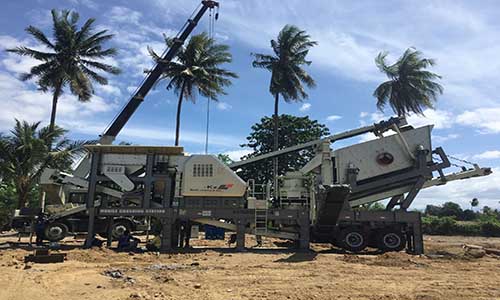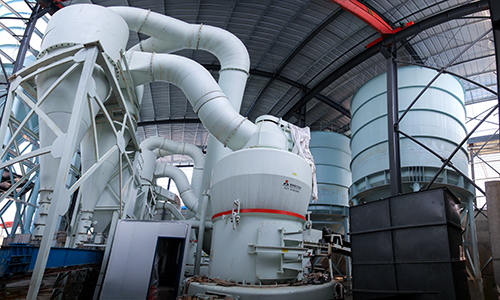اترك رسالة

Gyratory and Cone Crusher ScienceDirect
The breaking head gyrates inside an inverted truncated cone These crushers are designed so that the headtodepth ratio is larger than the standard

(PDF) Cone Crusher Performance ResearchGate
PhD Thesis Cone crushers are used by both the aggregate producing and the mining industry Both industries are interested in increasing the product quality while at the same time lowering the

Chamber Optimization for Comprehensive Improvement
Introduction As one of the key equipment in the bulk materials crushing system, the cone crusher is mainly used for the medium and fine crushing of bulk materials With the continuous promotion of
Gyratory Crusher SpringerLink
Gyratory crusher is a crushing equipment that uses the gyratory motion of the crushing cone in the conical cavity inside the shell to extrude, bend, and impact
Gyratory and Cone Crusher ScienceDirect
Abstract Detail descriptions of designs are given of large gyratory crushers that are used as primary crushers to reduce the size of large runofmine ore
Stone Crushers: A Technical Review on Significant Part of
Secondary crusher Inertia cone crusher Design Modeling of realtime dynamic model of inertia cone crusher using EDEM software For model verification, the industrialscale
Gyratory and Cone Crusher ScienceDirect
Figure 51 is a typical sketch of a large gyratory crusher used as a primary crusher to reduce the size of large pieces of rocks produced during blasting in mines Variations in the design of the breaking head and the mantle have been adopted by different manufacturers Such variations are adopted from studies on stress distributions of
Unveiling the Advantages and Applications of
Gyratory cone crushers are powerful machines that have revolutionized the crushing industry Their unique design and superior performance make them a popular choice for a wide range of

Crushing and Screening Handbook AusIMM
the crusher and scalp out fi nes Primary gyratory crushers ideally suited to all highcapacity primary hard rock crushing applications Jaw crushers we have more installed jaw crushers than anyone in the world The leading choice due to their high reduction ratio and heavy duty design Cone crushers capacities available to suit all

Our Range of Trio® Cone Crushers Weir
Trio® TC Series Cone Crushers The Trio® TC Series cone crusher is the latest iteration of the liveshaft cone crusher This design has been proven to perform in heavyduty secondary and tertiary crushing applications being tough, reliable, simple to operate and easy to maintain They are also effective for pebble crushing applications

Gyratory Crushers vs Cone Crushers: What Are the Main
The gyratory crushers’ design involves a rotating spindle and a crushing head, usually a truncated cone, rotating in eccentric motion within the bowl Cone Crushers On the other hand, a cone crusher, also known as a crusher cone, operates similarly to gyratory crushers, but the design is somewhat different Cone crushers are smaller and

Stone Crushers: A Technical Review on Significant Part of
Secondary crusher Inertia cone crusher Design Modeling of realtime dynamic model of inertia cone crusher using EDEM software For model verification, the industrialscale experimentation was performed on a GYP1200 inertia cone crusher 2020 Cheng et al [18] China 15 Secondary crusher Cone crusher Analytical
Mathematical Modeling and MultiCriteria Optimization of Design
One of the main tasks in designing a singleroll gyratory crusher is to choose the shape and size of the working chamber When determining the rational profile of the jaw, the main requirement is the ability to capture a piece of rock having a maximum size d max (approximately 300 mm for mine crushers), and keeping the piece during crushing

A review of modeling and control strategies for cone crushers
The minimum distance between the mantle and concave is defined as the closed side setting (CSS) of the cone crusher The CSS is easily changed online in a large variety of commercial crushers; different principles of CSS adjustment are described in (Quist, 2017)The maximum distance between the mantle and concave, on the other

(a) Structure diagram and (b) functional principle diagram of cone crusher
Mathematical modeling and optimization of the design parameters of the working chamber and the executive body (roll) of a singleroll gyratory shaft crusher, designed for crushing strong rocks

1,2,*,Patricio Toledo 1 2 MDPI
Several gyratory and cone crushers have been simulated with DEM Litcher et al proposed a twoway coupling DEMPBM (Population Balance Model) model of cone crushers [13], where the PBM was used to represent the size reduction in the particles A B90 cone crusher and a HP100 cone crusher were simulated, and the particle size
Gyratory and Cone Crusher ScienceDirect
Descriptions of secondary and tertiary cone crushers that usually follow gyratory crushers are also given in detail The practical method of operation of each type of gyratory crusher is indicated and the various methods of computing operating variables such as speed of gyration, capacities and power consumption given are prescribed by
Cone Crushers MEKA
MEKA cone crushers are an excellent choice as secondary crushers in combination with a jaw or a primary gyratory crusher or in the third or fourth crushing stage When you need a crusher for aggregates

Gyratory Crusher SpringerLink
Gyratory crusher is a crushing equipment that uses the gyratory motion of the crushing cone in the conical cavity inside the shell to extrude, bend, and impact materials, for the purpose of coarse crushing of the materials of various hardness It was invented in the USA in the 1870s The equipment specification is usually represented by

Stone Crushers: A Technical Review on Significant Part of
The cone crusher is shown in Fig 4 Are somewhat similar to gyratory type in construction It has larger diameter crushing surface and very short spindle relative to its vertical crosssection The spindle is not swinging as in the gyratory crusher The eccentric motion of the inner crushing cone is almost similar to gyratory type

Crusher an overview ScienceDirect Topics
The cone crusher (Fig 1312) is very similar to the gyratory type, except that it has a much shorter spindle with a largerdiameter crushing surface relative to its vertical dimension The spindle is not suspended as in the gyratory crusher The eccentric motion of the inner crushing cone is similar to that of the gyratory crusher

Geometric analysis of cone crusher liner shape ScienceDirect
This simplicity also allowed the Whiten crusher model (Whiten, 1972) to describe jaw crusher performance with only three parameters K1 which correlates with CSS, K2 which relates to OSS and t 10 which provides for a similar degree of severity of breakage for each particle which is caught and a probability curve for captureThe

Why is the cone crusher known as a gyratory crusher? LinkedIn
The cone crusher is known as a gyratory crusher because it uses a rotating coneshaped head to break material into smaller pieces This type of crusher is commonly used in the mining and aggregate

AMIT 135: Lesson 5 Crushing Mining Mill Operator Training
Rule 1: Always use a jaw crusher if you can due to lower costs Rule 2: For low capacity applications, use jaw crusher and hydraulic hammer for oversize Rule 3: For high capacities, use jaw crusher with big intake openings Rule 4: For very high capacities, use gyratory crusher
Cone Crushers (Parts of a Cone Crusher) Explained saVRee
Cone Crusher CrossSection The spring cone crusher design is able to pass uncrushable materials eg tramp metal, through the crushing cavity by using springs The first hydraulic cone crusher was developed in 1948 and this allowed for the opening of the crushing cavity hydraulically, instead of using springs (mechanical actuation) Both the
Simulation and optimization of gyratory crusher performance
1 Introduction The gyratory crusher is widely used in primary crushing of metal ore such as iron ore and copper ore due to its high productivity and large feed inlet [[1], [2], [3]]In recent years, with the growth of the world's population, the development of urbanization and the improvement of living standards, the demand for the ore continues